Abstract
Of 250 patients referred to the Stanford Sleep Disorders Clinic, 35 were diagnosed for a sleep induced apnea syndrome. Thirty of them (27 adults and 3 children) were nonobese and complained of a sleep disorder. In 12 patients (9 adults and 3 children) extensive cardiorespiratory workups were done during sleep and wakefulness. Three types of sleep induced apnea syndrome were identified: diaphragmatic (or central), obstructive and mixed. The diaphragmatic type was predominant in sleep apnea insomnia; obstructive was predominant in sleep apnea hypersomnia. Hemodynamic changes were documented during sleep. Tracheostomy, done in two cases, improved the sleep induced symptomatology.
Full text
PDF


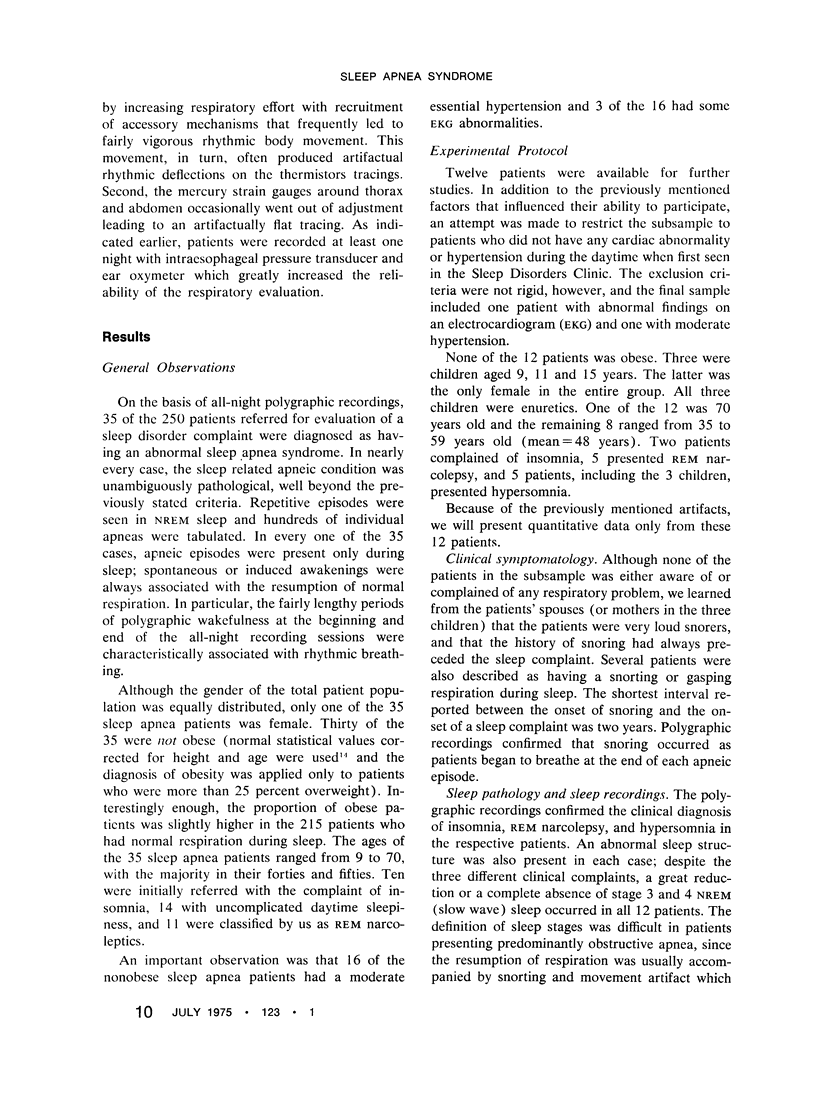

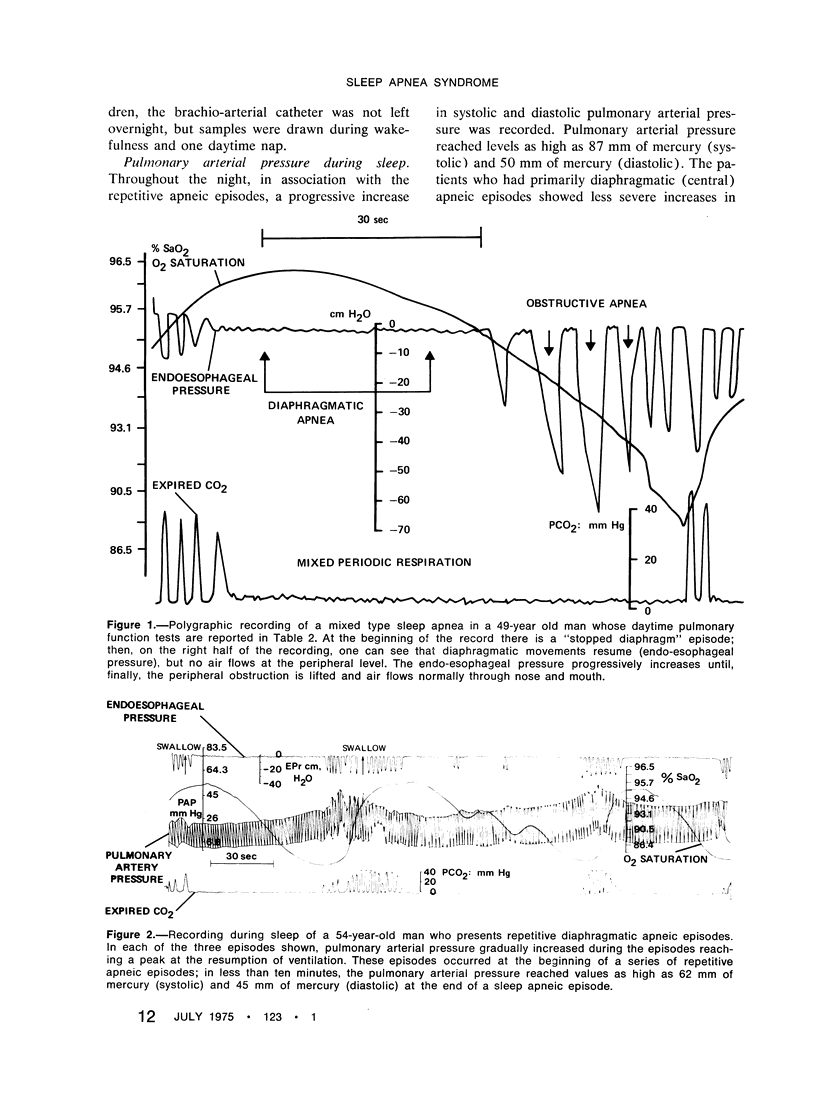
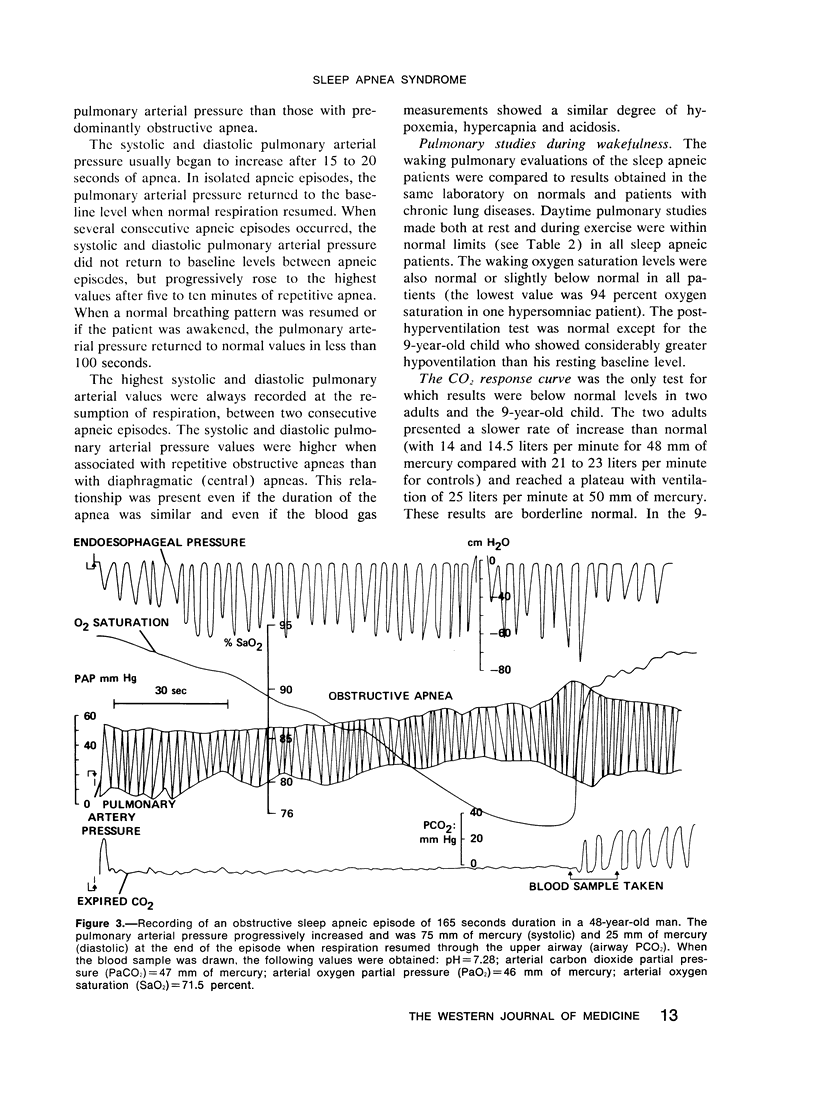
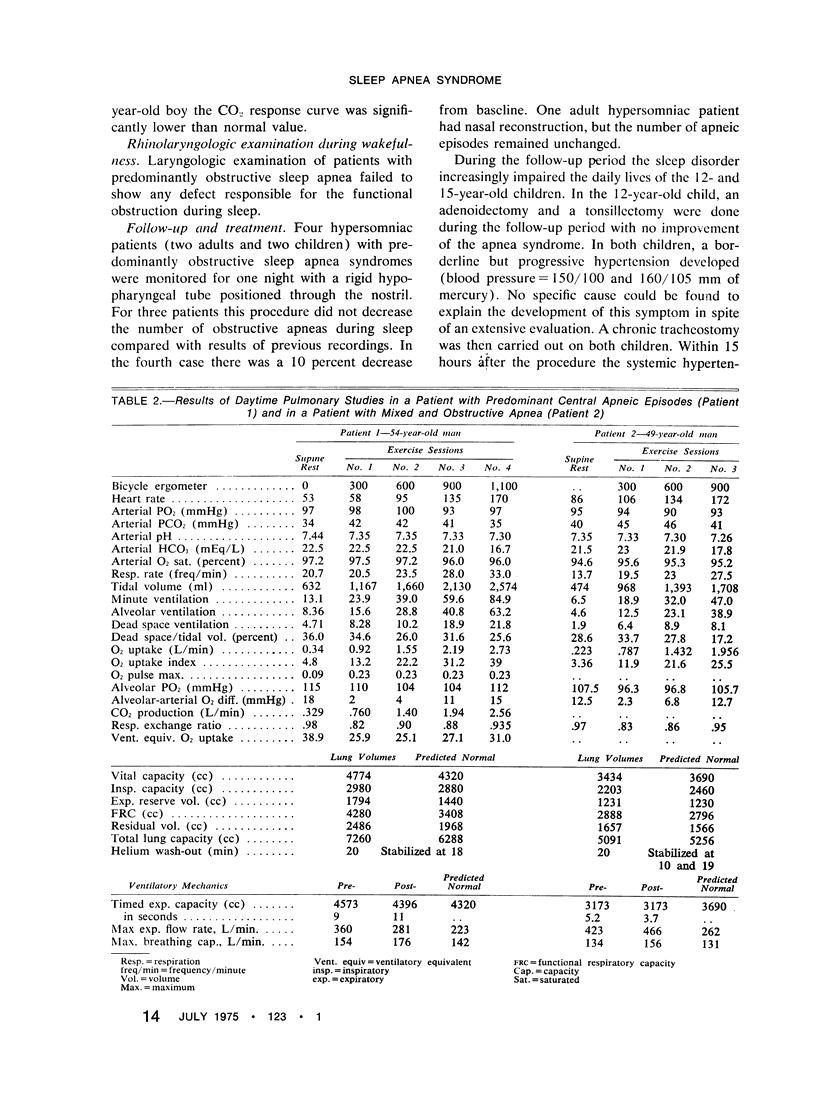
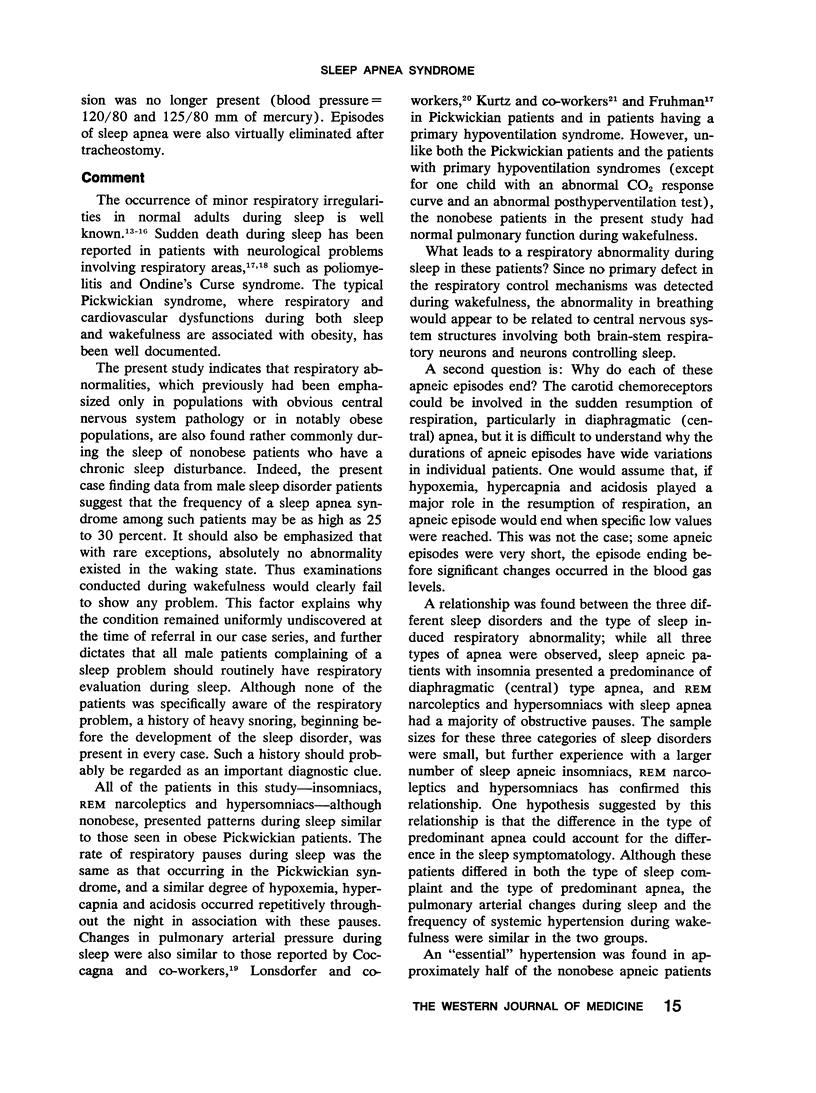
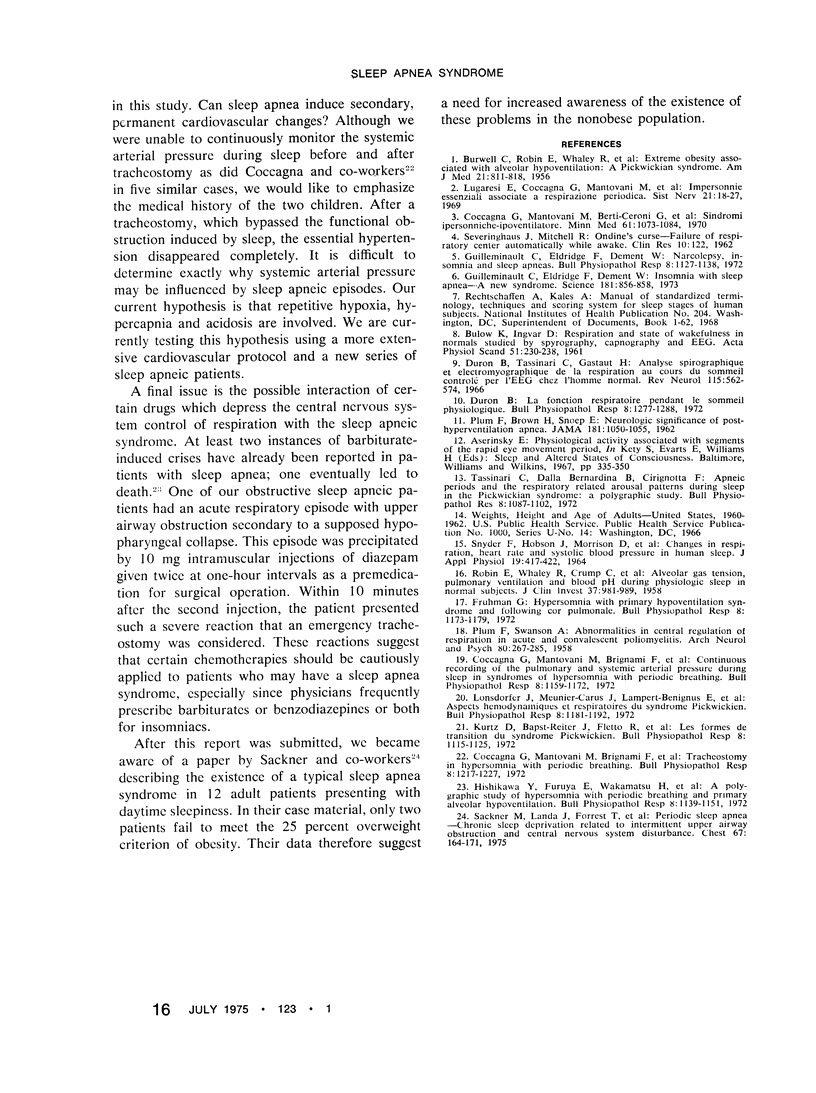
Selected References
These references are in PubMed. This may not be the complete list of references from this article.
- Aserinsky E. Physiological activity associated with segments of the rapid eye movement period. Res Publ Assoc Res Nerv Ment Dis. 1967;45:338–350. [PubMed] [Google Scholar]
- BICKELMANN A. G., BURWELL C. S., ROBIN E. D., WHALEY R. D. Extreme obesity associated with alveolar hypoventilation; a Pickwickian syndrome. Am J Med. 1956 Nov;21(5):811–818. doi: 10.1016/0002-9343(56)90094-8. [DOI] [PubMed] [Google Scholar]
- Coccagna G., Mantovani M., Brignani F., Parchi C., Lugaresi E. Continuous recording of the pulmonary and systemic arterial pressure during sleep in syndromes of hypersomnia with periodic breathing. Bull Physiopathol Respir (Nancy) 1972 Sep-Oct;8(5):1159–1172. [PubMed] [Google Scholar]
- Coccagna G., Mantovani M., Brignani F., Parchi C., Lugaresi E. Tracheostomy in hypersomnia with periodic breathing. Bull Physiopathol Respir (Nancy) 1972 Sep-Oct;8(5):1217–1227. [PubMed] [Google Scholar]
- Coccagna G., Mantovani M., Ceroni G. B., Pazzaglia P., Petrella A., Lugaresi E. Sindromi ipersonniche-ipoventilatorie. Considerazioni sui rapporti fisiopatologici e nosografici tra sindrome pickwickiana, ipoventilazione alveolare primaria e narcolessia a sonno lento. Minerva Med. 1970 Mar 17;61(22):1073–1084. [PubMed] [Google Scholar]
- Duron B., Tassinari C. A., Gastaut H. Analyse spirographique et électromyographique de la respiration au cours du sommeil contrôlé par l'E.E.G. chez l'homme normal. Rev Neurol (Paris) 1966 Sep;115(3):562–574. [PubMed] [Google Scholar]
- Guilleminault C., Eldridge F. L., Dement W. C. Insomnia with sleep apnea: a new syndrome. Science. 1973 Aug 31;181(4102):856–858. doi: 10.1126/science.181.4102.856. [DOI] [PubMed] [Google Scholar]
- Guilleminault C., Eldridge F., Dement W. C. Insomnia, narcolepsy, and sleep apneas. Bull Physiopathol Respir (Nancy) 1972 Sep-Oct;8(5):1127–1138. [PubMed] [Google Scholar]
- Hishikawa Y., Furuya E., Wakamatsu H., Yamamoto J. A polygraphic study of hypersomnia with periodic breathing and primary alveolar hypoventilation. Bull Physiopathol Respir (Nancy) 1972 Sep-Oct;8(5):1139–1151. [PubMed] [Google Scholar]
- Kurtz D., Bapst-Reiter J., Fletto R., Micheletti G., Meunier-Carus J., Lonsdorfer J., Lampert-Benignus E. Les formes de transition du syndrome Pickwickien. (Séméiologie et distribution des apnées. Bull Physiopathol Respir (Nancy) 1972 Sep-Oct;8(5):1115–1125. [PubMed] [Google Scholar]
- Lonsdorfer J., Meunier-Carus J., Lampert-Benignus E., Kurtz D., Bapst-Reiter J., Fletto R., Micheletti G. Aspects hémodynamiques et respiratoires du syndrome Pickwickien. Bull Physiopathol Respir (Nancy) 1972 Sep-Oct;8(5):1181–1192. [PubMed] [Google Scholar]
- PLUM F., BROWN H. W., SNOEP E. Neurologic significance of posthyperventilation apnea. JAMA. 1962 Sep 22;181:1050–1055. [PubMed] [Google Scholar]
- PLUM F., SWANSON A. G. Abnormalities in central regulation of respiration in acute and convalescent poliomyelitis. AMA Arch Neurol Psychiatry. 1958 Sep;80(3):267–285. doi: 10.1001/archneurpsyc.1958.02340090003001. [DOI] [PubMed] [Google Scholar]
- ROBIN E. D., WHALEY R. D., CRUMP C. H., TRAVIS D. M. Alveolar gas tensions, pulmonary ventilation and blood pH during physiologic sleep in normal subjects. J Clin Invest. 1958 Jul;37(7):981–989. doi: 10.1172/JCI103694. [DOI] [PMC free article] [PubMed] [Google Scholar]
- SNYDER F., HOBSON J. A., MORRISON D. F., GOLDFRANK F. CHANGES IN RESPIRATION, HEART RATE, AND SYSTOLIC BLOOD PRESSURE IN HUMAN SLEEP. J Appl Physiol. 1964 May;19:417–422. doi: 10.1152/jappl.1964.19.3.417. [DOI] [PubMed] [Google Scholar]
- Sackner M. A., Landa J., Forrest T., Greeneltch D. Periodic sleep apnea: chronic sleep deprivation related to intermittent upper airway obstruction and central nervous system disturbance. Chest. 1975 Feb;67(2):164–171. doi: 10.1378/chest.67.2.164. [DOI] [PubMed] [Google Scholar]
- Tassinari C. A., Dalla Bernardina B., Cirignotta F., Ambrosetto G. Apnoeic periods and the respiratory related arousal patterns during sleep in the Pickwickian syndrome. A polygraphic study. Bull Physiopathol Respir (Nancy) 1972 Sep-Oct;8(5):1087–1102. [PubMed] [Google Scholar]


